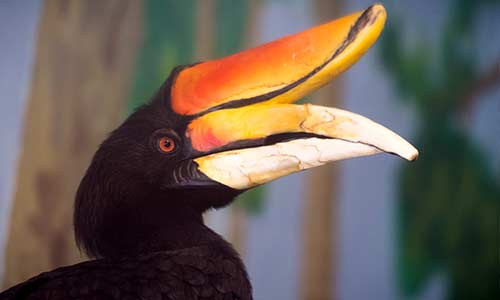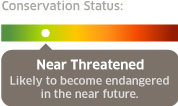Appearance:
Rhinoceros hornbills can weigh upwards of 6 pounds and measure almost 3 feet long. They have black feathers on their bodies and white feathers on their legs. Their tails are white with a black band. Both the beak and casque are orange and red in color.
Diet:
Hornbills eat mostly fruits, but will occasionally eat insects and small animals.
Reproduction:
The female hornbills lays her eggs in a hollow tree cavity, and with help from the male, seals herself and her eggs inside with a paste made of fruit, mud and feces. Only a small slit is left open so that the male can pass food to the female (and later, the chicks) for four to five months. The female breaks herself out when the chicks are old enough, but the male and female seal the chicks back up again for several more months until the chicks are old and strong enough to break out of the nest on their own.
Behavior:
Rhinoceros hornbills spend most of their time high up in the canopy of tropical forests. Their large wingspans and long tail feathers allow them to gracefully fly from one branch to another. Hornbills typically mate for life.
Habitat/Range:
Hornbills live in large trees in tropical rainforests in several countries in Southeast Asia, including Indonesia, Thailand, Sumatra, and Malaysia.
Median Life Expectancy:
35 years
Fun Fact:
The rhinoceros hornbill is the national bird of Malaysia.



